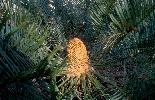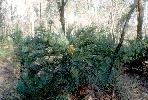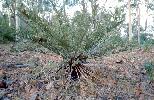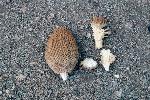Species profile—Cycas ophiolitica (Marlborough blue)
Classification
Plantae (plants) → Equisetopsida (land plants) → Cycadaceae → Cycas ophiolitica (Marlborough blue)

Go to Photo gallery
Species details
- Kingdom
- Plantae (plants)
- Class
- Equisetopsida (land plants)
- Family
- Cycadaceae
- Scientific name
- Cycas ophiolitica K.D.Hill
- Common name
- Marlborough blue
- WildNet taxon ID
- 8437
- Nature Conservation Act 1992 (NCA) status
- Endangered
- Environment Protection and Biodiversity Conservation Act 1999 (EPBC) status
- Endangered
- Conservation significant
- Yes
- Confidential
- Yes
- Endemicity
- Native
- Pest status
- Nil
- Short Notes
- Gymnosperm, three sheets
- Description
- Cycas ophiolitica is a small to medium sized cycad, with an erect trunk and a spreading to rounded crown. The trunk is 14-20cm in diameter and grows up to 2m tall, rarely to 4m. The young leaves are powdery blue in colour and densely covered with greyish or brown hairs. The mature leaves are 95-140cm long, glossy blue-green to dark green and keeled (V-shaped) in cross-section. The petiole (leaf stalk) is 18-35cm long, hairy. Each leaf consists of 170-220 leathery leaflets arranged in two rows along a rhachis (central stalk). The leaflets are 15-24cm long and 0.6- 0.75mm wide, with slightly recurved margins. The lowest leaflets are reduced to spine-like structures about 0.5cm long.
The male and female reproductive structures develop on separate plants. Male plants produce brown, hairy cylindrical cones 14-17cm long and 6-8cm in diameter. The female plants produce loose, open cone-like structures at the top of the plant. Two to six seeds are borne on female sporophylls (seed bearing structures) up to 30cm long, that have a broad flat spear-shaped tip (apical lobe) with an apical spine to 2cm long. As the seeds mature, the stalks lengthen and spread away from the top of the plant. The seeds are ovoid (egg-shaped) to spherical, about 3cm in diameter, light brown and often with a thin powdery coating.
Cycas ophiolitica is distinguished from C. media by the orange wool in the crown, the hairy petioles and the narrower, more crowded leaflets. It is distinguished from C. megacarpa by the narrower, more crowded leaflets and much smaller seeds. (Halford 1995; Hill 1998; Forster 2001; DEWHA 2008) - Map
- View Map
- Habitat
- Cycas ophiolitica inhabits eucalypt open forest and woodland communities with a grassy understorey. They occur on hill tops or steep slopes, at altitudes of 80-620m above sea level. It grows on shallow, stony, red clay loams or sandy soils. (Halford 1995)
- Reproduction
- Cycas ophiolitica is pollinated by small beetles. Seed becomes ripe from March onwards, when it drops from the plant. The seeds are not ready to germinate for at least nine months due to the delayed fertilisation unique to cycads. The species occurs in habitats that are subjected to periodic fires of varying intensities. As with other cycads, adult plants are resistant to most fires, although the foliage may be destroyed and the stems may be scarred. Fires may kill small seedlings or seed that is either on the plant or locally dispersed. (Queensland Herbarium 2007)
- Management documents
- Conservation and management of protected plants in trade in Queensland 1995-1998. Department of Environment.
Queensland Herbarium (2007). National Multi-species Recovery Plan for the cycads, Cycas megacarpa, Cycas ophiolitica, Macrozamia cranei, Macrozamia lomandroides, Macrozamia pauli-guilielmi and Macrozamia platyrhachis. Report to Department of the Environment and Water Resources, Canberra. Environmental Protection Agency, Brisbane. - Notes
- Contributors: Ailsa Holland, Mellisa Mayhew 17/06/2009
- References
- Department of the Environment, Water, Heritage and the Arts (2008). Cycas ophiolitica in Species Profile and Threats Database, Department of the Environment, Water, Heritage and the Arts, Canberra. Accessed 29/09/2008. http://www.environment.gov.au/cgi-bin/sprat/public/sprat.pl
Forster, P.I. (2001). Cycas cupida (Cycadaceae), a new species from central Queensland. Austrobaileya 6(1): 156.
Halford, D. (1995). Cycas ophiolitica, in Species Management Manual. Department of Natural Resources, Brisbane.
Herbrecs (2008). Cycas ophiolitica, in BriMapper version 2.12. Queensland Herbarium. Accessed 29/09/2008.
Hill, K. (1992). A preliminary account of Cycas (Cycadaceae) in Queensland. Telopea 5(1): 177-206.
Hill, K.D. in McCarthy, P.M. (Ed) (1998). Flora of Australia 48: 610.
Queensland Herbarium (2007). National Multi-species Recovery Plan for the cycads, Cycas megacarpa, Cycas ophiolitica, Macrozamia cranei, Macrozamia lomandroides, Macrozamia pauli-guilielmi and Macrozamia platyrhachis. Report to Department of the Environment and Water Resources, Canberra. Environmental Protection Agency, Brisbane. http://www.environment.gov.au/biodiversity/threatened/publications/pubs/cycads.pdf - Profile author
- Ailsa Holland (17/06/2009)
Other resources
- Species Profile and Threats Database (SPRAT)
- The Australasian Virtual Herbarium (AVH)
- Atlas of Living Australia
Data source
This profile data is sourced from the QLD Wildlife Data API using the Get species by ID function used under CC-By 4.0.
https://apps.des.qld.gov.au/species/?op=getspeciesbyid&taxonid=8437.
This information is sourced from the WildNet database managed by the Queensland Department of Environment and Science.





